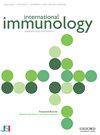皮肤在特应性进展中的作用。
IF 4.8
4区 医学
Q2 IMMUNOLOGY
引用次数: 0
摘要
特应性疾病,包括特应性皮炎(AD)、食物过敏(FA)、哮喘和过敏性鼻炎(AR)与涉及不同身体部位(即皮肤、气道和消化道)的炎症性疾病密切相关,其特征包括对过敏原的特异性 IgE(所谓的 "特应性")和 Th2 细胞介导的炎症。人们已经认识到,渐冻人症往往先于其他特应性疾病的发生。从婴儿期的过敏性鼻炎发展到儿童后期的过敏性鼻炎或哮喘/过敏性鼻炎被称为 "特应性进展"(AM)。临床、遗传和实验研究已经提供了证据,证明通过 AD 皮肤发生的过敏原致敏可能是特应性哮喘的起源。在此,我们对皮肤在特应性哮喘中的作用进行了最新综述,从与 AD 和特应性哮喘中表皮屏障功能障碍相关的基因突变和环境因素,到皮肤过敏的免疫学机制,特别是最近在研究 AD 期间表皮角质形成细胞或浸润皮肤的免疫细胞产生的关键细胞因子的功能方面取得的进展。我们还强调了制定针对 AD 皮肤的策略以预防和减轻 AM 的重要性。本文章由计算机程序翻译,如有差异,请以英文原文为准。
The role of the skin in the atopic march.
Atopic diseases, including atopic dermatitis (AD), food allergy (FA), asthma, and allergic rhinitis (AR) are closely related to inflammatory diseases involving different body sites (i.e. the skin, airway, and digestive tract) with characteristic features including specific IgE to allergens (so-called 'atopy') and Th2 cell-mediated inflammation. It has been recognized that AD often precedes the development of other atopic diseases. The progression from AD during infancy to FA or asthma/AR in later childhood is referred as the 'atopic march' (AM). Clinical, genetic and experimental studies have provided evidence that allergen sensitization occurring through AD skin could be the origin of the AM. Here, we provide an updated review focusing on the role of the skin in the AM, from genetic mutations and environmental factors associated with epidermal barrier dysfunction in AD and the AM, to immunological mechanisms for skin sensitization, particularly recent progress on the function of key cytokines produced by epidermal keratinocytes or by immune cells infiltrating the skin during AD. We also highlight the importance of developing strategies that target AD skin to prevent and attenuate the AM.
求助全文
通过发布文献求助,成功后即可免费获取论文全文。
去求助
来源期刊

International immunology
医学-免疫学
CiteScore
9.30
自引率
2.30%
发文量
51
审稿时长
6-12 weeks
期刊介绍:
International Immunology is an online only (from Jan 2018) journal that publishes basic research and clinical studies from all areas of immunology and includes research conducted in laboratories throughout the world.
 求助内容:
求助内容: 应助结果提醒方式:
应助结果提醒方式:


